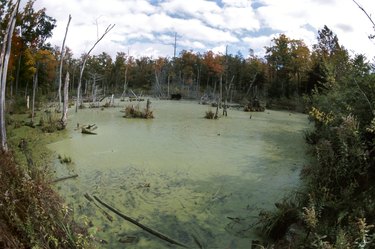Things You'll Need
Saw
Trencher
Wading boots
Rake
Shovel
55-gallon metal barrel
Electric drill
3 /8-inch drill bit
Truck or bobcat
Boat
Heavy-duty drainage pump
Excavator
Dredge boat
Dump truck

Dredging is a method of underwater excavation that is used to clear sediment and foliage from the bottom of creeks, ponds, lakes and other water sources. Accumulated sediment can pose a navigational risk to boats and can create a bad smell and cause excessive aquatic vegetation to grow. Drainage ditches that have accumulated excessive amounts of foliage and debris can interrupt the flow of water and cause flooding. Depending on the location, municipal zoning laws and the Federal Clean Water Act may require you to obtain a permit before you can dredge water yourself.
Ditch Dredging
Step 1
Cut and clear any fallen trees and other debris from around the ditch. Also cut any new growth that may be impeding the flow of water.
Video of the Day
Step 2
Use a trencher to dig out and remove the foliage and debris that has accumulated at the bottom of the ditch.
Step 3
Increase the depth of the trench if necessary. Make sure the bottom is flat and the walls are narrow at the base and wide at the top. This will help facilitate the flow of water.
Hand Dredging
Step 1
Use a rake to scrape the bottom of the pond. Start in the center and work your way out in a spoke pattern going clockwise. Wear wading boots if you have to enter the pond.
Step 2
Drag the silt to shore and spread it out to dry.
Step 3
Use a shovel to dig out foliage and sediment from ponds that are small enough to dredge from the shoreline.
Bucket Dredging
Step 1
Drill several holes into the bottom and sides of a 55-gallon metal barrel. Use an electric drill and 3 /8-inch drill bit.
Step 2
Tie a heavy-duty steel cable around the barrel.
Step 3
Tie the other end of the cable to a truck hitch or bobcat. Roll the barrel into the water so that the open side is pointing in the direction of the machine being used to pull the barrel. You can also attach the cable to a boat to dredge larger ponds.
Step 4
Start the engine of the truck or bobcat and begin dragging the barrel across the pond. The barrel will collect silt and allow the water to escape through the holes. It will need to be emptied frequently.
Step 5
Pull the barrel out of the pond and deposit the silt on the shore to dry. Repeat this process until the pond has been dredged.
Drain Dredging
Step 1
Attach a hose to a heavy-duty submersible drainage pump and run the free end of the hose far enough away from the pond that the water does not drain back in.
Step 2
Turn the pump on and drain the water completely.
Step 3
Allow the bed of the pond to dry before excavating. Wet foliage and sediment can cause the excavator to become stuck.
Step 4
Scrape the bed of the pond with an excavator blade. Remove the silt to a location that it can dry out and that is far enough away from the pond that it cannot reenter. The pond can be refilled once the bed has been cleared.
Dock and Deep Water Dredging
Step 1
Park a large dump truck near the shore or dock. The suction hose will deposit the silt into the dump truck.
Step 2
Release a dredge boat into the water near your dock. Maneuver the boat to the area you wish to dredge and connect the suction hose to the dump truck.
Step 3
Release the suction hose into the water and turn the pump on. For large open water areas, you may have to empty the dump truck several times.
Tip
Silt will feel mucky and soft. You have reached the true bottom of the pond when the shovel meets with some resistance. Dredged silt is rich in nutrients and can be mixed with compost and spread over yards and gardens.
Video of the Day